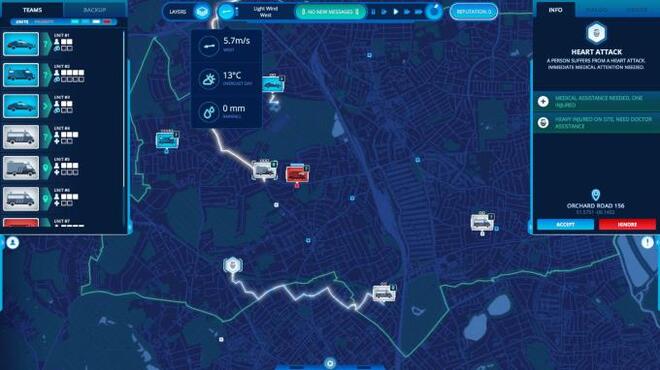An article on license key generation. Hi, The 'Windows Insider Build 17115' has a LARGE BUG in it and when you attempt to download a File the Banner at the bottom of the screen shows 'Running Security Scan' and Hangs at that point. 112 Operator Crack Only YAML 0.39 KB. Share download clone embed report. How to Download NOTE: For safe and fast download use JDownloader for FTP Links. The motives of the free workers who slide on the 112 Operator Crack are in no way inspired and the deadly occupant of such a family will honor their profession, arguing that it is not the same helpline for the ceremony, but a phone line to support life.

For a new or existing pipeline segment to be eligible for operation at the alternative maximum allowable operating pressure (MAOP) calculated under § 192.620, a segment must meet the following additional design requirements. Records for alternative MAOP must be maintained, for the useful life of the pipeline, demonstrating compliance with these requirements:



| To address this design issue: | The pipeline segment must meet these additional requirements: |
|---|---|
| (a) General standards for the steel pipe | (1) The plate, skelp, or coil used for the pipe must be micro-alloyed, fine grain, fully killed, continuously cast steel with calcium treatment. |
| (2) The carbon equivalents of the steel used for pipe must not exceed 0.25 percent by weight, as calculated by the Ito-Bessyo formula (Pcm formula) or 0.43 percent by weight, as calculated by the International Institute of Welding (IIW) formula. | |
| (3) The ratio of the specified outside diameter of the pipe to the specified wall thickness must be less than 100. The wall thickness or other mitigative measures must prevent denting and ovality anomalies during construction, strength testing and anticipated operational stresses. | |
| (4) The pipe must be manufactured using API Spec 5L, product specification level 2 (incorporated by reference, see § 192.7) for maximum operating pressures and minimum and maximum operating temperatures and other requirements under this section. | |
| (b) Fracture control | (1) The toughness properties for pipe must address the potential for initiation, propagation and arrest of fractures in accordance with: |
| (i) API Spec 5L (incorporated by reference, see § 192.7); or | |
| (ii) American Society of Mechanical Engineers (ASME) B31.8 (incorporated by reference, see § 192.7); and | |
| (iii) Any correction factors needed to address pipe grades, pressures, temperatures, or gas compositions not expressly addressed in API Spec 5L , product specification level 2 or ASME B31.8 (incorporated by reference, see § 192.7). | |
| (2) Fracture control must: | |
| (i) Ensure resistance to fracture initiation while addressing the full range of operating temperatures, pressures, gas compositions, pipe grade and operating stress levels, including maximum pressures and minimum temperatures for shut-in conditions, that the pipeline is expected to experience. If these parameters change during operation of the pipeline such that they are outside the bounds of what was considered in the design evaluation, the evaluation must be reviewed and updated to assure continued resistance to fracture initiation over the operating life of the pipeline; | |
| (ii) Address adjustments to toughness of pipe for each grade used and the decompression behavior of the gas at operating parameters; | |
| (iii) Ensure at least 99 percent probability of fracture arrest within eight pipe lengths with a probability of not less than 90 percent within five pipe lengths; and | |
| (iv) Include fracture toughness testing that is equivalent to that described in supplementary requirements SR5A, SR5B, and SR6 of API Specification 5L (incorporated by reference, see § 192.7) and ensures ductile fracture and arrest with the following exceptions: | |
| (A) The results of the Charpy impact test prescribed in SR5A must indicate at least 80 percent minimum shear area for any single test on each heat of steel; and | |
| (B) The results of the drop weight test prescribed in SR6 must indicate 80 percent average shear area with a minimum single test result of 60 percent shear area for any steel test samples. The test results must ensure a ductile fracture and arrest. | |
| (3) If it is not physically possible to achieve the pipeline toughness properties of paragraphs (b)(1) and (2) of this section, additional design features, such as mechanical or composite crack arrestors and/or heavier walled pipe of proper design and spacing, must be used to ensure fracture arrest as described in paragraph (b)(2)(iii) of this section. | |
| (c) Plate/coil quality control | (1) There must be an internal quality management program at all mills involved in producing steel, plate, coil, skelp, and/or rolling pipe to be operated at alternative MAOP. These programs must be structured to eliminate or detect defects and inclusions affecting pipe quality. |
| (2) A mill inspection program or internal quality management program must include (i) and either (ii) or (iii): | |
| (i) An ultrasonic test of the ends and at least 35 percent of the surface of the plate/coil or pipe to identify imperfections that impair serviceability such as laminations, cracks, and inclusions. At least 95 percent of the lengths of pipe manufactured must be tested. For all pipelines designed after December 22, 2008, the test must be done in accordance with ASTM A578/A578M Level B, or API Spec 5L Paragraph 7.8.10 (incorporated by reference, see § 192.7) or equivalent method, and either | |
| (ii) A macro etch test or other equivalent method to identify inclusions that may form centerline segregation during the continuous casting process. Use of sulfur prints is not an equivalent method. The test must be carried out on the first or second slab of each sequence graded with an acceptance criteria of one or two on the Mannesmann scale or equivalent; or | |
| (iii) A quality assurance monitoring program implemented by the operator that includes audits of: (a) all steelmaking and casting facilities, (b) quality control plans and manufacturing procedure specifications, (c) equipment maintenance and records of conformance, (d) applicable casting superheat and speeds, and (e) centerline segregation monitoring records to ensure mitigation of centerline segregation during the continuous casting process. | |
| (d) Seam quality control | (1) There must be a quality assurance program for pipe seam welds to assure tensile strength provided in API Spec 5L (incorporated by reference, see § 192.7) for appropriate grades. |
| (2) There must be a hardness test, using Vickers (Hv10) hardness test method or equivalent test method, to assure a maximum hardness of 280 Vickers of the following: | |
| (i) A cross section of the weld seam of one pipe from each heat plus one pipe from each welding line per day; and | |
| (ii) For each sample cross section, a minimum of 13 readings (three for each heat affected zone, three in the weld metal, and two in each section of pipe base metal). | |
| (3) All of the seams must be ultrasonically tested after cold expansion and mill hydrostatic testing. | |
| (e) Mill hydrostatic test | (1) All pipe to be used in a new pipeline segment installed after October 1, 2015, must be hydrostatically tested at the mill at a test pressure corresponding to a hoop stress of 95 percent SMYS for 10 seconds. |
| (2) Pipe in operation prior to December 22, 2008, must have been hydrostatically tested at the mill at a test pressure corresponding to a hoop stress of 90 percent SMYS for 10 seconds. | |
| (3) Pipe in operation on or after December 22, 2008, but before October 1, 2015, must have been hydrostatically tested at the mill at a test pressure corresponding to a hoop stress of 95 percent SMYS for 10 seconds. The test pressure may include a combination of internal test pressure and the allowance for end loading stresses imposed by the pipe mill hydrostatic testing equipment as allowed by “ANSI/API Spec 5L” (incorporated by reference, | |
| (f) Coating | (1) The pipe must be protected against external corrosion by a non-shielding coating. |
| (2) Coating on pipe used for trenchless installation must be non-shielding and resist abrasions and other damage possible during installation. | |
| (3) A quality assurance inspection and testing program for the coating must cover the surface quality of the bare pipe, surface cleanliness and chlorides, blast cleaning, application temperature control, adhesion, cathodic disbondment, moisture permeation, bending, coating thickness, holiday detection, and repair. | |
| (g) Fittings and flanges | (1) There must be certification records of flanges, factory induction bends and factory weld ells. Certification must address material properties such as chemistry, minimum yield strength and minimum wall thickness to meet design conditions. |
| (2) If the carbon equivalents of flanges, bends and ells are greater than 0.42 percent by weight, the qualified welding procedures must include a pre-heat procedure. | |
| (3) Valves, flanges and fittings must be rated based upon the required specification rating class for the alternative MAOP. | |
| (h) Compressor stations | (1) A compressor station must be designed to limit the temperature of the nearest downstream segment operating at alternative MAOP to a maximum of 120 degrees Fahrenheit (49 degrees Celsius) or the higher temperature allowed in paragraph (h)(2) of this section unless a long-term coating integrity monitoring program is implemented in accordance with paragraph (h)(3) of this section. |
| (2) If research, testing and field monitoring tests demonstrate that the coating type being used will withstand a higher temperature in long-term operations, the compressor station may be designed to limit downstream piping to that higher temperature. Test results and acceptance criteria addressing coating adhesion, cathodic disbondment, and coating condition must be provided to each PHMSA pipeline safety regional office where the pipeline is in service at least 60 days prior to operating above 120 degrees Fahrenheit (49 degrees Celsius). An operator must also notify a State pipeline safety authority when the pipeline is located in a State where PHMSA has an interstate agent agreement, or an intrastate pipeline is regulated by that State. | |
| (3) Pipeline segments operating at alternative MAOP may operate at temperatures above 120 degrees Fahrenheit (49 degrees Celsius) if the operator implements a long-term coating integrity monitoring program. The monitoring program must include examinations using direct current voltage gradient (DCVG), alternating current voltage gradient (ACVG), or an equivalent method of monitoring coating integrity. An operator must specify the periodicity at which these examinations occur and criteria for repairing identified indications. An operator must submit its long-term coating integrity monitoring program to each PHMSA pipeline safety regional office in which the pipeline is located for review before the pipeline segments may be operated at temperatures in excess of 120 degrees Fahrenheit (49 degrees Celsius). An operator must also notify a State pipeline safety authority when the pipeline is located in a State where PHMSA has an interstate agent agreement, or an intrastate pipeline is regulated by that State. |
112 Operator Crack Key
